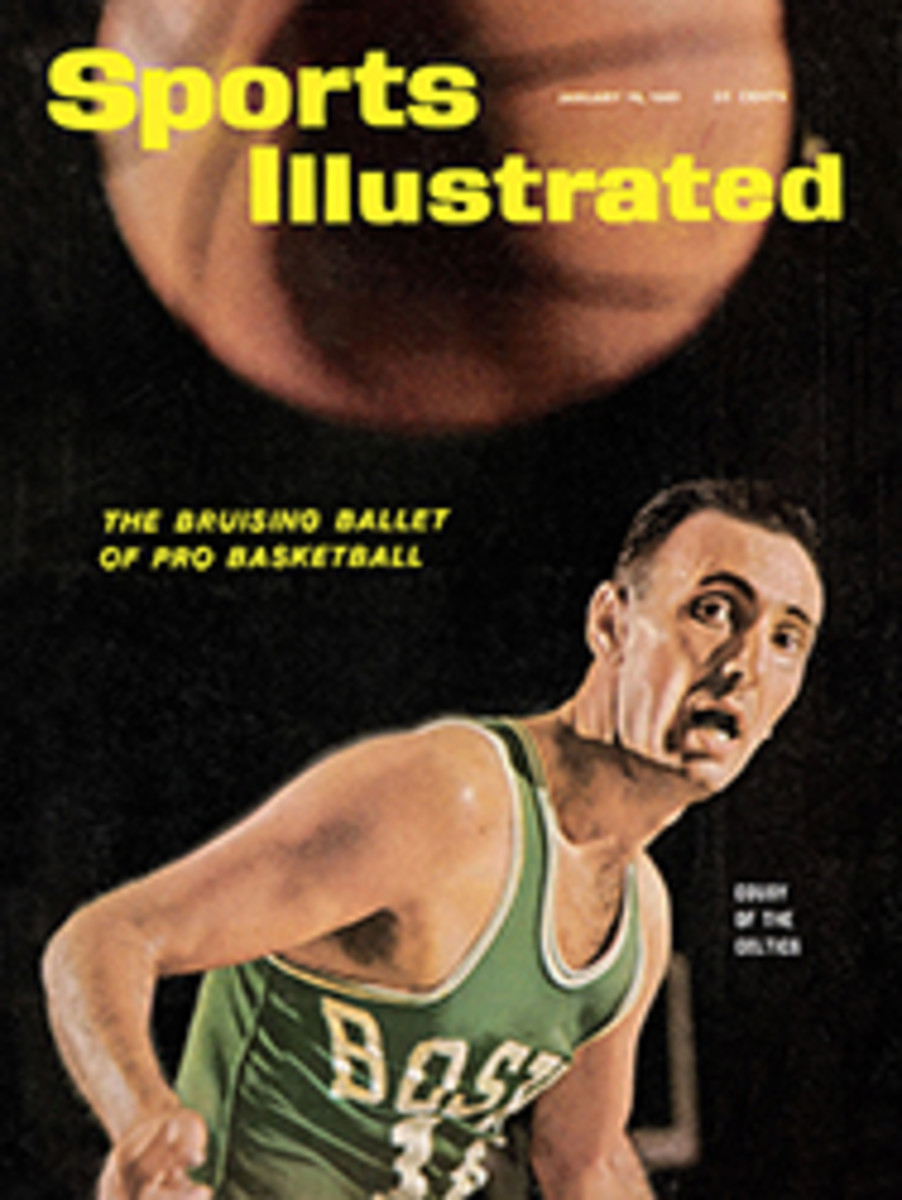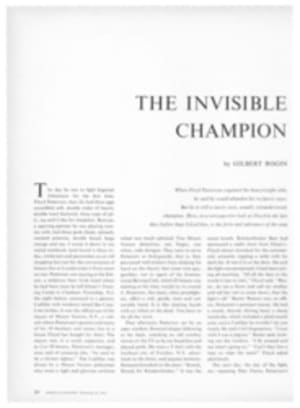
A skipper from scratch
Frederick E. (Ted) Hood of the famous sailing port of Marblehead is a laconic fellow, but he has a combination of talents seldom found in a single sailor. At 33, Ted Hood is one of the top half dozen sailors in the country. He is one of the two or three top sailmakers. Recently he began designing sailing hulls—with immediate success. If Roger Maris manufactured the bats he used, sold them to all the very best players and successfully managed the Giants, he would hold a comparable position in baseball.
Hood's most recent feat in competitive sailing was in August when he came down to the New York Yacht Club cruise (a series of prestige events) with a new centerboard yawl of his own design carrying Hood sails, and beat the fleet for the Astor Cup.
"Our crew was just three couples," said Hood, "and the girls weren't too used to sailing. The men got pretty tired running around and changing the sails. Some of the other boats had seven strong men on board."
This is a long speech for Ted. He probably made it because he couldn't resist giving the New Yorkers the old Yankee rub. Ordinarily he is a mixture of grave reserve, some shyness (which lessens considerably after a drink) and deep underlying warmth.
In the office of his sail loft, he is ill at ease with strangers. He glances quickly from under a mop of dark hair when asked a question, fiddling with objects on his desk. The questioner is likely to have a long wait for the answer, such as it is. John Collins, a close friend, says he sailed with Hood for three years without being able to remember a single instance when Ted spoke long enough to complete a paragraph. When sailing, Ted's young and pretty wife Susan never bothers to ask her husband what is going on, but always asks the crew instead.
Yet Hood makes it clear that, in his opinion, he is a successful sailmaker because he makes better sails than anyone else. And he is not bashful about seizing opportunity. When the 1954 hurricane hit New England, Hood bought boats for salvage, fixed them and sold out at a good profit. These profits were added to those of the loft, which grossed $80,000 that year and which will gross $300,000 this year.
In the last America's Cup trials, three boats used Hood's sails wholly or partly, and the successful defender, Columbia, flew a Hood spinnaker. This is about as much prestige as a sailmaker can get.
In the America's Cup trials Hood's talent for sailing came in just as handy as his sails. He was picked for the sailing brain trust on the 19-year-old Vim, which almost defeated newer and presumably faster candidates. When Hood arrives at any race, he mixes sailmaking with sailing. He spends much of his time helping skippers with their sails. He makes mental notes—so his friend Collins says—on how the next sail for that particular boat should be cut.
In 1949 Hood was a year away from graduation at Wentworth Institute in Boston. He decided to try sailmaking full time. His total resources were himself, one stitcher and a lot of faith. The first sails were laid out in a room over a tavern in a building picturesque even by Marblehead standards. It was located on State Street, one of the town's narrow, hilly and cobbled streets. When he started making money, Ted moved to a larger place a few feet from the ocean down on Marblehead's craggy, rock-laden Little Harbor. Here he set up looms to weave his own cloth. He doesn't think anyone can make cloth the way he wants it, so he weaves his own—the only sailmaker who does.
As Hood's sails became known, so did his sailing. In 1951 he took the first of four consecutive titles in the elite Marblehead International class fleet ("We did fair," says Ted).
In 1956, during his preparations for the U.S. Olympic trials, Hood practically deserted sailmaking. He and Collins and Don McNamara, a hot racer in the Boston-to-Marblehead area, persuaded well-known Marblehead architect Ray Hunt to plan a new 5.5-meter, Quixotic, for expenses only. Hood employed a local carpenter who used the same tools his grandfather used in building the old Bedford whalers. Quixotic did supremely well in the trials, and to win, Hood needed only to finish better than last in the final, deciding race. Midway in the course a shackle parted and the sail on Hood's boat dropped into the cockpit. He finished last.
"It was depressing," said Hood afterward, "to sit there and try to figure out what to do."
Hood seldom seems ruffled. He sits at the helm with a small smile on his face, watching the sails and the wind. Collins recalls one race when Ted was in the lead but the time limit was running out fast, and the wind was dying just as fast. As the boat inched for the finish, two of the crew, a married couple inexperienced in sailing, walked artlessly about, knocking the wind out of the sails and throwing the boat off balance. Hood said nothing, showed no temper and won the race with 20 seconds to spare under the time limit.
North American champion
This is the same quality that enabled Hood, a week after what should have been the shattering experience of losing an Olympic berth by mishap, to successfully enter the preliminaries for the North American sailing title. He squeaked ahead in the final and became the 1956 North American sailing champion. "It was a drifting match," he recalls, "but we won."
George O'Day, who imports and builds popular-size racing craft, and Hood raced against each other last year in the Olympic trials in what yachting columnist Leonard Fowle called "one of yachting's great all-time competitions." Hood and O'Day were one-two all the way for the 5.5-meter-class Olympic berth. In the last race they were only 97 Olympic points apart, the difference between fourth and fifth place. In the deciding moments Hood lost by a whisper.
He made no excuses. "It was a question of who beat who. Suppose I'll give it another try in four years," said Ted.
In the meantime, Hood has been developing his third talent as a man of boats: designing. "I was always interested in building a boat," he told a visitor not long ago. "At 16 I was going to build a 60-footer, but I ended up hammering together a 12-foot dinghy.
"I'd just sketch away some nights," said Hood when asked how he conceived his first design for a big boat. He took the drawings to his engineer father, Stedman Hood, and the two of them came up with what Ted calls "Just a good comfortable cruising boat." But Robin, a centerboard sloop, turned out to be more than that. In the 1959 Astor Cup she outraced, boat for boat, all the entries in her division, all the boats in the next larger division, all but three in the next to largest and four boats in the largest division. Her handicap easily gave Robin the overall win.
Then Ted sold Robin and busied himself with new designs. Last summer he came up with not one, but four Robin-type boats, built for him in Japan. "Couldn't afford to waste the money on testing models," said Hood when asked why he wanted four. Translated, this meant he wanted to try various rigs, decide which was best and sell the others.
He put a yawl rig on one, named it Robin after his first design, and the week it was launched it took a first and a second in the Edgartown Regatta off Martha's Vineyard, and three firsts including the 1960 Astor Cup in the New York Yacht Club races. Back in Marblehead again, Robin took three more firsts. It almost made a chatterbox of Ted. "I was pleased to see her go so well," he said.
He is reticent about plans to market more Robin-type hulls and sails to go with them, meeting all questions with, "I guess I could..." and "I might if I sell these..."
Marbleheaders are betting that by the time his four boats are gone there will be others on the way and Hood will be solidly established as a boat designer. Their only question is whether he will want his own forest for wood, and his own sawmill.
PHOTO
SKIPPER HOOD RACES FOR GLORY OF HOOD SAILS AND HULLS
PHOTO
HOOD SAILS FLYING, HOOD-DESIGNED "ROBIN" SCOOTS DOWNWIND

